How To Play Piano By Ear – The Ultimate Guide
 Would you like to learn how to play piano by ear?
Would you like to learn how to play piano by ear?
You’ve come to the right place.
In this lesson, you’ll learn how to start picking out tunes by listening
You’ll also learn common patterns and techniques to speed up the process.
Let’s get started.
1. The Most Important Skill To Learn How To Play Piano By Ear
 The most important skill you need to learn is audiation.
The most important skill you need to learn is audiation.
According to Edwin Gordon, audiation is the skill of being able to imagine music accurately in our minds.
This includes being able to imagine any process associated with that music in our mind’s “ear”.
The best musicians are able to do at least two things:
- Accurately imagine the music about to be played in the real world.
- Precisely visualize how the music being imagined should be played on the instrument.
Audiation applies equally to both reading sheet music, playing from memory, and improvising.
Now let’s look at the 7 steps how to play piano by ear.
2. Seven Steps How To Play Piano By Ear
 These 7 steps will help you learn how to audiate to be able to play piano by ear:
These 7 steps will help you learn how to audiate to be able to play piano by ear:
- Listen to the tune many times.
- Sing the melody. Memorize it.
- Learn and master the melody on your piano.
- Learn the chords.
- Play the melody with your right hand while playing the chords with the left hand.
- Rearrange the song according to your desired style. If you have developed the chops for it, you can even go reharmonize it.
- Have fun.
These are all the steps that you need to pick out tunes simply by listening to it.
But, there may still be things you can hear in your head but you can’t play yet.
How do you address that problem?
The solution can be found below:
3. Six Important Items To Speed Up Learning How To Play Piano By Ear
 In the process of learning a song by ear, there might be some things you can’t play.
In the process of learning a song by ear, there might be some things you can’t play.
It’s frustrating. However, there’s one key to getting over that frustration.
It’s the ability to recognize patterns.
Composers and improvisers use patterns all the time.
Being fluent in those various patterns is the key to understanding anything you want to play by ear.
Here are the most important patterns you need in order to pick out songs by ear:
A. Scales
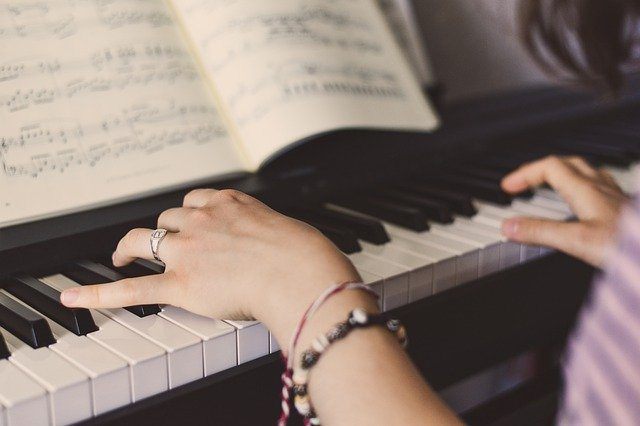 Scales are your ABCs of music.
Scales are your ABCs of music.
In fact, scales are always the basis by which melodies and harmonies are written.
The most important scale to learn and understand is the major scale.
Starting from a root note, the formula in whole steps and half steps is W-W-h-W-W-W-h.
In scale degrees, this is your straight 1-2-3-4-5-6-7.
Here are the other important scales you should learn (in scale degrees)
- Major pentatonic – 1-2-3-5-6
- Minor pentatonic – 1-b3-4-5-b7
- Blues – 1-b3-4-b5-5-b7
- Harmonic minor – 1-2-b3-4-5-b6-7
- Melodic minor –1-2-b3-4-5-6-7
- Lydian – 1-2-3-#4-5-6-7
- Mixolydian – 1-2-3-4-5-6-b7
- Half-whole diminished – 1-b2-b3-3-#4-5-6-b7
- Whole tone – 1-2-3-#4-#5-#6
- Altered – 1-b9-#9-3-#11-#13-b7
- Major Bebop – 1-2-3-4-5-b6-6-7
- Bebop Dominant – 1-2-3-4-5-6-b7-7
- Bebop Harmonic Minor – 1-2-b3-4-5-b6-b7-7
- Bebop Melodic Minor – 1-2-b3-4-5-b6-6-7
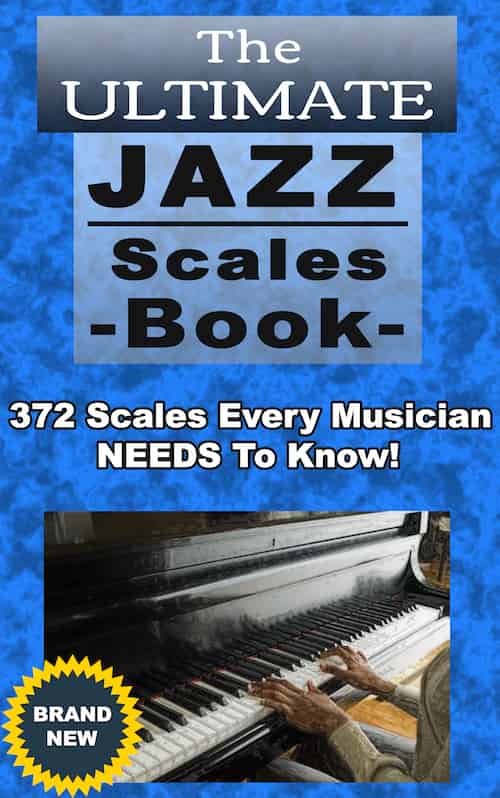 What if you don’t know all your scales yet? A great way to learn all your piano scales is is through the Ultimate Jazz Scales Book.
What if you don’t know all your scales yet? A great way to learn all your piano scales is is through the Ultimate Jazz Scales Book.
Inside the Ultimate Jazz Scales Book, you’ll learn the above important scales you can use to learn songs faster, make better solos, and learn faster.
This will help you improve your melodic vocabulary and reinforce your understanding of music more.
Here’s where you can get a copy of the Ultimate Jazz Scales Book.
B. Intervals
Intervals are simply the distances between two notes.
You need to learn how distinguish by ear and play all intervals on the piano.
It’s also a must to hear these intervals both melodically and harmonically.
What Intervals Should You Focus On?
To get you started here is a list of intervals that you’ll want to train your ear to hear.
- Minor 2nd (m2)
- Major 2nd (M2)
- minor 3rd (m3)
- Major 3rd (M3)
- Perfect 4th (P4)
- Augmented 4th or tritone (TT)
- Perfect 5th (P5)
- minor 6th (m6)
- Major 6th (M6)
- minor 7th (m7)
- Major 7th (M7)
- Octave
Once you can easily start hearing some intervals your next step will be start recognizing melodic patterns within scales. This is really fun as you’ll see below.
C. Scale/Melodic Sequences & Patterns
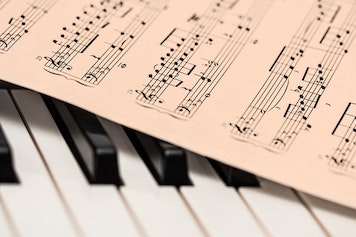 Playing your scales simply up and down is not musical at all.
Playing your scales simply up and down is not musical at all.
This is why you need to practice your scales in note sequences.
Examples of note sequences are:
- Skipping in 3rds
- 3-note sequences
- 4-note sequences
- Intervallic sequences
- Coltrane patterns
- Arpeggios across the scale
Being able to quickly recognize scale patterns helps you play piano by ear faster.
This is because composers make use of various combinations of note sequences to come up with melodies.
D. Chords And Chord Voicings
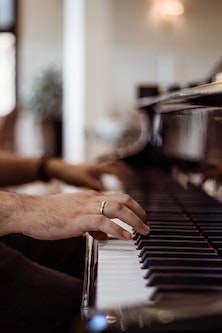 Here is a list of the must-learn chords and chord voicings to play piano by ear:
Here is a list of the must-learn chords and chord voicings to play piano by ear:
- Basic triads
- 7th and extended chords
- Shell voicings
- Quartal voicings
- Rootless voicings
- Drop 2 voicings
It’s also very important to learn how to play these voicings in all of the available inversions
E. Stylistic Comping Patterns
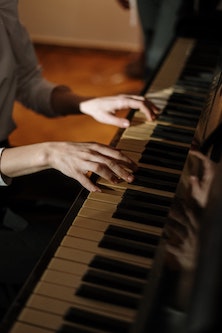 Here are a few important stylistic comping patterns to learn:
Here are a few important stylistic comping patterns to learn:
- Charleston rhythm
- Jazz Swing rhythms (anticipation, delayed attack, etc.)
- Walking Bass
- Arpeggio patterns for left hand, right hand, and both hands
- 2/3 and 3/2 Son Clave Rhythm
- Rhumba
- Bossa Nova
- Walking Bass
-
Left-hand stride piano
This will help you accompany yourself
F. Licks And Phrases
 Practicing these items by singing and playing over and over will training your ears to recognize them.
Practicing these items by singing and playing over and over will training your ears to recognize them.
This will also help you pick up these patterns when you hear them in songs.
Here are some licks you can learn to get you started:
Learning jazz theory will also exponentially increase your ability to learn new music by ear.
Now to go to the next level, do you think all of these is enough?
How To Go Beyond Your Limits
 Have you hit a wall in your playing?
Have you hit a wall in your playing?
Does it feel like your skills aren’t going anywhere?
It does seem like YouTube is the easiest and most convenient way to take your skills to the next level.
However, you just end up being disappointed of your results after tons of experimentation and YouTube videos.
Why not save time and effort by mentorship from pros who know exactly what it takes?
This is where the Jazz Inner Circle comes in.
Our Jazz Inner Circle faculty consists of award-winning, world-touring jazz pianists.
They know exactly what it takes to go from nothing to conquering the world’s stage.
Best of all, they’re ready to share you tried and tested methods that will help you rise to the next level.
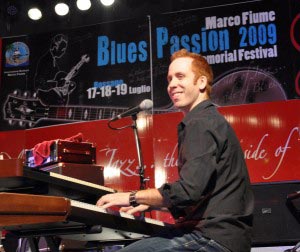 Inside the Jazz Inner Circle, you’ll discover:
Inside the Jazz Inner Circle, you’ll discover:
- Private 1:1 lessons with a Jazz Inner Circle instructor.
- “The Jazz Piano Mastery Program” (Over $25,000 worth of jazz piano training resources, tools, practice templates, improv strategies, & tons more.)
- Access to over 50 hours of high-level jazz intensive workshops.
Get one-on-one jazz piano training with us here.
I hope that this lesson answered your questions about how to play piano by ear.
If you have more questions, comments, or suggestions for the next lesson, let us know in the comments section below.
Happy practicing.
